This week we continue our play-through of the “Totensonntag” Pint-Sized Campaign for Chain of Command. Previous episodes can be found here:
Part 1: Introduction to “Totensonntag”
Part 2: Let the Battle Begin!
Part 3: A Delaying Action
Part 4: Flank Attack!
In the previous scenario, the Germans were able to capture one vehicle and destroy another, but the escape of a South African water bowser meant that in terms of campaign Victory Points, the German side was unable to significantly expand its lead in score. After three scenarios, the score currently stands at 16-9 in favor of the Germans.
In order to showcase how well Chain of Command serves up uncertainty and fog-of-war, previous games in this series were played solo. Not so this installment, which took place during one of our regular miniature gaming group’s meet ups at The Garage. And in fact, I didn’t actually play in it at all, just refereed and took pictures.
Instead, the South Africans were played by my friend John. This is bit of a “full circle” kind of thing because it was actually John who first introduced me to Chain of Command back in early 2016. He had invited me to play some Bolt Action previously, but I hadn’t really gotten hooked. But it only took one game of CoC and I was literally buying miniatures the next day. My entire US Infantry platoon is comprised of Black Tree minis I bought secondhand off John, and they were some of the first WW2 minis I painted (along with my DAK, a bunch of which I also bought off John).
His opponent on the evening in question was Lily, whom I first met at this year’s FlintCon. She actually played in one of the games I ran there, which was essentially the first mission of this campaign. As such, she was familiar with how all the dust and smoke and whatnot worked. It turns out she’s comparatively local to where we live, and since we first met she has become part of our regular wargaming crew. Lily gives me hope for the future of the historical wargaming hobby – she’s young and enthusiastic and a huge history buff, and at this point I think I can safely say she knows more about tanks than I do. Because of this, she was well-suited to play the Germans in this game.
The Mission
The mission for this stage of the campaign is “swift to support” from the Blitzkrieg 1940 handbook. The primary goal of the attacker is to capture all three of the defender’s Jump-Off Points, and the defender is trying to keep that from happening at all costs. As always in this particular Pint-Sized Campaign, this mission also has the secondary objective of the capture/escape of the South African support vehicles to complicate both players’ lives.
While the mission itself is very straightforward, the scenario does offer one significant wrinkle – the defender cannot bring on any of their Support Choices until after the end of the first Turn. Not the first Phase – the first Turn. Because turn ends are an uncertain thing in Chain of Command, this could be a significant amount of time. Or not. Either way, they South Africans are going to be looking for every Command Die result of 5 they can get their hands on to build up a CoC die to end the turn.
Similarly, this presents something of a problem to the Germans – outright capturing an objective vehicle requires that the vehicle have at least a two-man infantry team present and that the turn is ended. So if the Germans end the turn to capture a vehicle, they just make it easier for the South Africans to bring on their support. Decisions, decisions…
Setup
Again there will be four burning wrecks on the table at the beginning of the game. One of these ends up being very close to a table edge, and this time the wind is blowing straight down the battlefield from north to south. This will give long lanes of fire down the table, but make it hard for units to fire across the table. As it turns out, this would become important.
The three objective vehicles were a supply truck, an ammunition truck, and a troop transport. After randomizing their starting positions, this was the state of the table at the beginning of the Patrol Phase:
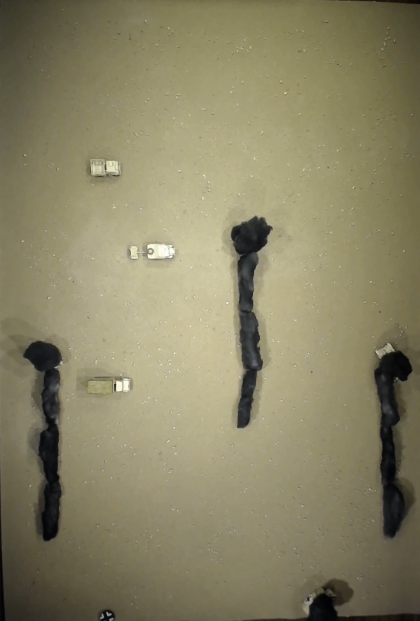
Choosing Supports
In solo games, choosing supports can be a little strange. There are some very interesting systems out there (such as “Platoon Forward”) that can do a good job of introducing some uncertainty here, and I have used those on occasion in my solo games. But this is one area where simply having a human opponent can introduce so much more uncertainty to the game. Not knowing what your opponent is going to be throwing at you can be nerve-wracking, and to make sure that was the case for this mission I took each player aside and discussed their mission goals, campaign goals, and potential options.
This mission represents a turning point in the battle – by this stage the Germans were well and truly intermingled with the South African formation and had begun pushing into parts of the brigade artillery. As such, the South Africans no longer have the option to take a pre-game barrage. Ever the forward-thinker, John opted to spend two of his 7 support points on unit upgrades. He agonized over whether or not to bump the second Senior Leader up from green to regular, but in the end he decided that since the Germans would be barreling straight toward his JOPs that upgrading the two of his three infantry squads would give him units that he could deploy to guard those positions who wouldn’t surrender at the first sign of an enemy tank. With the remaining 5 points, he put all his eggs in a single basket and elected to bring a 25-lb artillery gun (which at the ranges represented in this battle would be firing over open sights – something they very much did on that day). This was a huge gamble, because as mentioned above support units cannot be brought on until after the end of the first Turn. That left him with the following:
- A 25-lb artillery gun with 5 crew and Junior Leader (5 points)
- Permanently upgrade one Team, Section, or Senior Leader from Green to Regular (2nd Section, 1 point)
- Permanently upgrade one Team, Section, or Senior Leader from Green to Regular (3rd Section, 1 point)
Aside: What about the upgraded units? Aren’t those technically “supports?” No, these are the core elements of the South African force, and even though they have mixed experience and actually represent elements from different units that have become intermingled, they shouldn’t really be counted as “extra” in any way. Besides, this scenario is hard enough on the South Africans as it is, no need to dog-pile.
Aside: In this campaign the South Africans have an additional ace up their sleeve in the form of a “Wild Card” that can be played in any one game played during or after the 4th Campaign Turn (which this is). It represents the “breakout” by remnants of the British 22nd Armored Brigade midway through the battle. Though only a handful of tanks remained in that unit by this point, it still represented a spanner in the German plan. Playing this Wild Card gives the South African player two British Crusader tanks as free Supports. But since John wasn’t sure he’d even get out of the first game Turn to have the chance to deploy them, he chose to keep his powder dry and save this Wild Card for another battle.
In addition to the South Africans losing the pre-game barrage, the German forces have now pushed so deeply into the South African position that their own heavy artillery – sited far to the north atop a rocky ridge southeast of Tobruk called Belhamed – are within range. Take a moment to appreciate that: the Germans are attacking towards their own heavy artillery. That is how crazy this particular battle was. But as it turns out, that is perhaps not the best expenditure for the Germans, as a pre-game barrage comes to a halt at the end of the first Turn. But since the South Africans can’t deploy any of their supports in the first turn anyway, Lily chose to spend her points elsewhere (she had 13 thanks to Krauss still being liked by his CO).
In the end she chose a strategy very similar to what I went with in the 2nd mission – eschewing infantry and going heavy on tanks that provided strong high-explosive capabilities. She figured that she’d need to blast regular units in tactical stance off the enemy JOPs if she wanted to satisfy the mission’s primary objectives. And taking more tanks of course meant the desire to get Krauss on the table early, which meant taking an Adjutant. Similarly, coordinating the movement of many tanks is hard, which led her to pick the “Red Die,” an additional Command Die that can be used only for unit activation (i.e. 5s and 6s rolled on the die don’t count). Her last Support Choice surprised me: an empty Kubelwagen. When I reminded her that it had no crew or weapons (meaning it could neither drive nor shoot) she said, “Sure, but they don’t know that.” Her thinking here was that it could represent a potential capture threat, and if it confused the South Africans’ target priority even once, it just might be worth it. Time will tell if this works. After all this, the German Supports were:
- A Panzer IV D (5 points)
- A Panzer II C (4 points)
- An Adjutant (1 point)
- A “Red Die” (2 points)
- A Kubelwagen with no crew or weapons (1 point)
Force Morale
With both a +1 from the high morale of the men of the platoon and a +1 from Krauss’ current outlook, the Germans easily net the maximum score of 11 on their Force Morale. Saddled with a -2 modifier to their role, the South Africans get a fairly dismal starting Force Morale of 8 even after a pretty decent roll. This poses a significant risk for the South Africans – if the Germans can do things to drop the South Africans’ Force Morale before the end of the first turn, this could be over in a hurry.
Patrol Phase
Because we were playing at the garage, I was able to take advantage of the overhead camera to photograph each step of the Patrol Phase easily, without having to resort to standing on a chair or doing some contortions or a whole bunch of post-game photo editing. Hurray!
With the higher Force Morale, the Germans make the first move. This particular patrol phase was interesting to watch play out. There was actually a fair amount of back-and-forth, as both John and Lily tried to jockey to flank the other. John responded to a possible flanking move extremely aggressively (actually moving some markers backwards), which was an interesting strategy, and probably prevented the placement of a German JOP too far up the western board edge.
Similarly, at one point Lily made a very clever play, using one of her own locked markers to “screen” one that was still mobile – John couldn’t get a marker close enough to lock it down because he himself would have been locked down well short of the distance needed. In order to prevent her from swinging around and getting a decent JOP on the eastern board edge, he locked his last marker prematurely just to end the phase and deprive the Germans of another go.
The end result was a German JOP about a third of the way up the western board edge (where it could at least threaten one of the trucks) and two along the south edge. The South Africans managed one behind the northernmost objective truck, one behind a burning vehicle midfield (well placed for the deployment of a Senior Leader to keep the trucks moving), and one in the northeast corner. This last was pretty much as far as possible from the Germans’ starting positions to make the mission objective (capturing all of the South African JOPs) as difficult for the Germans as possible.
The Battle
With the higher Force Morale, the Germans started things off.
Turn 1, Phase 1 (German): 643311 – Haha! Finally an opening German Phase that didn’t completely suck. No, this one was quite good in fact. With an Adjutant in the rear and no pre-game barrage to fight through, the Germans wasted no time in deploying. They put on Krauss’ command tank, Berndt Ehrenreich’s #4 panzer, and the Pz IVD, all on overwatch and ready to menace anything the South Africans put down.
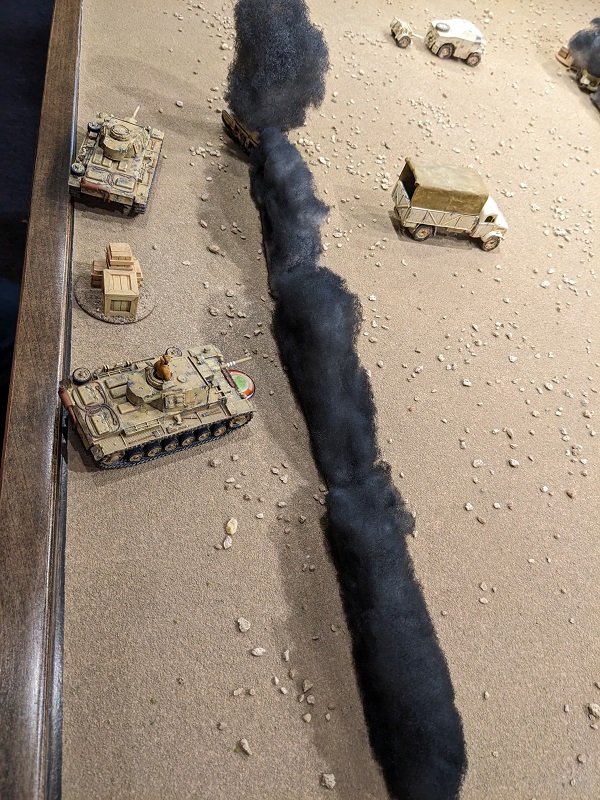
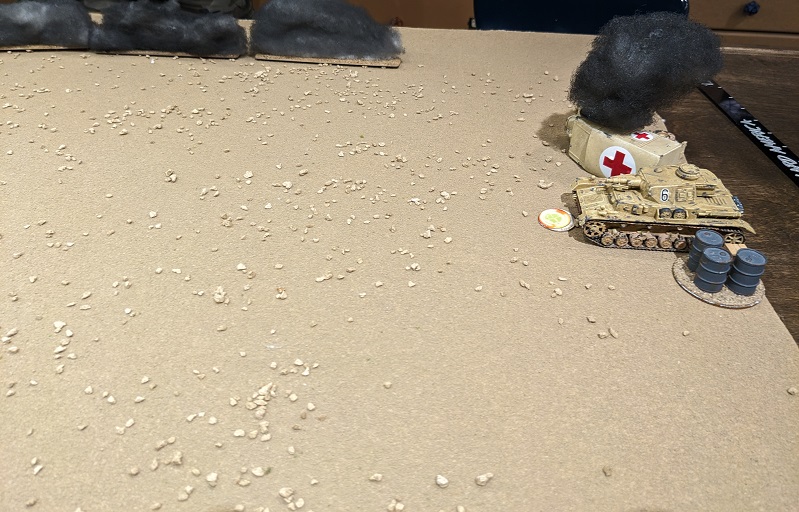
Turn 1, Phase 2 (South African): 53222 – Both of the units still subject to enforced deployment – a single section and a platoon NCO – had to be deployed with this roll. Entering the board from the central Allied JOP, the South African sergeant spent one CI telling the men of 1st Section to stay down, while spending another CI on each of the nearby support vehicles. Krauss’ tank took an overwatch shot at the speeding supply truck but missed through the smoke. John passed on the remaining 3 and kept the rest of his core platoon in reserve.
Sepp Borenhaas knew when he signed up for the army that the possibility he’d be shot at was a real one, but as a staff sergeant in the supply arm it was a blessed rarity. Sure, he’d been strafed on occasion by Italian or German aircraft, but for the most part the job was pretty safe all things considered. Not so today. Today was utter chaos. He had an entire section of clerks helping him try to get everything loaded onto trucks, and unfortunately their own transport was in the direction from which the Germans were coming. Getting as much gear as they could into the waiting vehicles, he was especially keen to get the ammo carrier moving – he didn’t want to be standing nearby when a trailer filled with an alarming number of artillery shells took a stray round and cooked off. Just then someone yelled, “Panzers!” and he looked up to see several German tanks approaching. Gesturing to his clerks and porters to get down, he yelled at the nearby truck drivers to get moving. The driver of the supply truck didn’t need to be told twice. Probably for the best, as Sepp saw a swirl in the dust as a high-velocity tank shell hurtled through the air where the vehicle had been mere seconds before. But the man driving the ammo carrier was clearly panicking and having trouble. Sepp could hear gears grinding as the vehicle lurched a short distance and stalled.
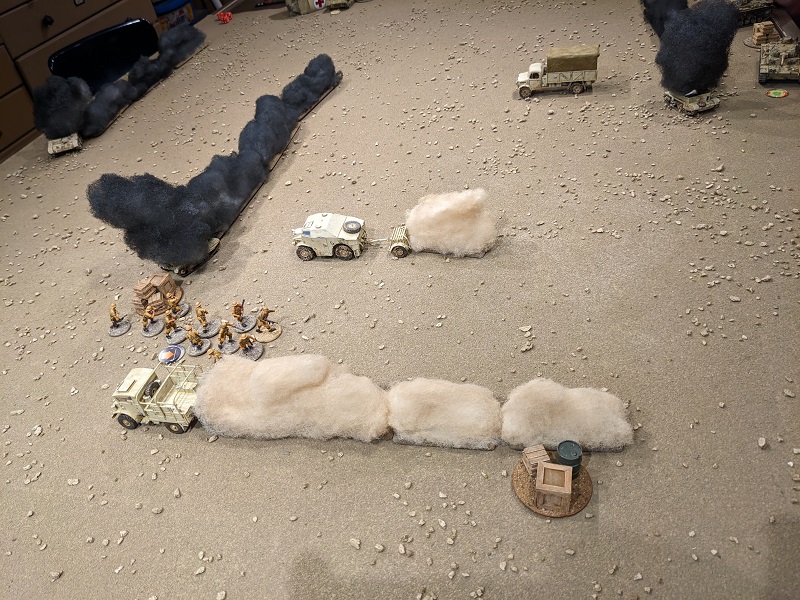
Turn 1, Phase 3 (German): 543221 – Using the 1, Lily chose this moment to deploy the “decoy” Kubelwagen, which came on near the burning ambulance.
Aside: How can you deploy a vehicle with no crew? We decided that it could be one of several things happening here – either the passengers realized that they had advanced too far and bailed in a way in which the enemy did not see them leave, or perhaps the vehicle had been there abandoned for a while and the South Africans had just noticed it through all the chaos. Either way, regardless of how the South Africans reacted the vehicle couldn’t move and was essentially a deception.
The very model of efficiency, Krauss orders the Pz IV D to advance via radio (it moves flat-out and covers 19″) while ordering his own driver to advance. Crossing through the smoke, he rolls up on the unsuspecting transport truck, whose driver wisely surrenders. Ehrenreich advances and directs his co-ax at the assorted clerks and porters of 1st Section but misses completely.
Observing the ludicrous spectacle through his own optics, Ehrenreich’s gunner chuckled as his rotund Unteroffizier failed to connect with his co-axial MG-34. “I thought you said you were some kind of huntsman. Why are you such a terrible shot?”
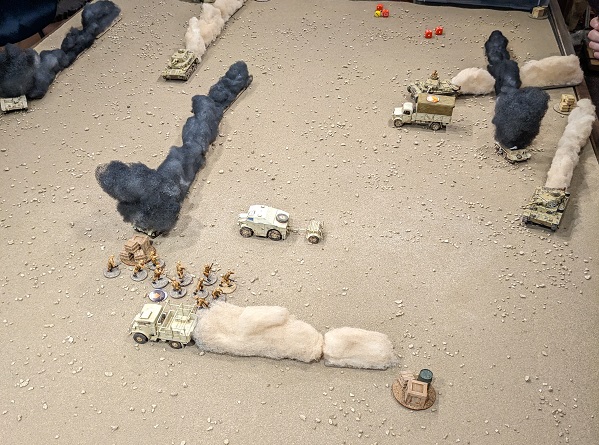
Turn 1, Phase 4 (South African): 65331 – Figuring that the ammo carrier was probably far enough away from Ehrenreich’s panzer to still be able to escape, John actually took the risk of deploying the Boys AT rifle here. It was calculated in that it gave him a side-armor shot at Ehrenreich. It was wasted when he rolled a 4 on 2D6 and missed. As a fallback, he deployed his 2nd Section (upgraded to regular) on the westernmost JOP to prevent its capture by the Germans. This is canny because while those infantry are in contact with the JOP the Germans can’t capture it, and since they’re no longer green they won’t surrender with the enemy tanks get close. But with no desire to put additional men in the line of fire, the South Africans pass on any further activations or deployments.

Turn 1, Phase 5 (German): 632221 – Krauss commands his own driver to advance a little bit to get better line of sight around the surrendered transport truck. While relatively short, this move allows him to bring his co-axial machinegun to bear on the recently-deployed Boys team. The shot proves to be devastatingly lethal and both men in the team are killed outright. Fortunately for the South Africans, their Force Morale holds firm. Krauss’ last CI is spent ordering the #4 tank to slowly advance. This lets Ehrenreich use his two CIs to activate both his hull and co-axial machineguns at 2nd Section. All that firepower results in just a single point of shock on the section’s Bren team. The Pz IV D also advances.
Turn 1, Phase 6 (South African): 66641 – This is what the South Africans had been waiting for. After the loss of the Boys team last phase, John was pretty worried that he’d be able to do anything to slow the German onslaught, but now the tables were about to turn. This roll of dice would end the Turn, which meant that next phase the South Africans could deploy their support. In the meantime, Sgt. Borenhaas kept himself busy, getting both of the nearby trucks moving before joining his wide-eyed clerks and heading east on foot. Meanwhile, a man from 2nd Section’s rifle team pitched a grenade at the nearby enemy panzer. By the rules-as-written it takes a CI from a leader to order a unit to throw one or more grenades, but in the absence of any other available AT weapon it seemed reasonable that some enterprising soldier would think to toss one out. And it actually did have some effect, causing Ehrenreich’s panzer to halt and engage 2nd Section next time it activated. That would keep it from shooting at the 25-lb gun, which all things considered was a good result.
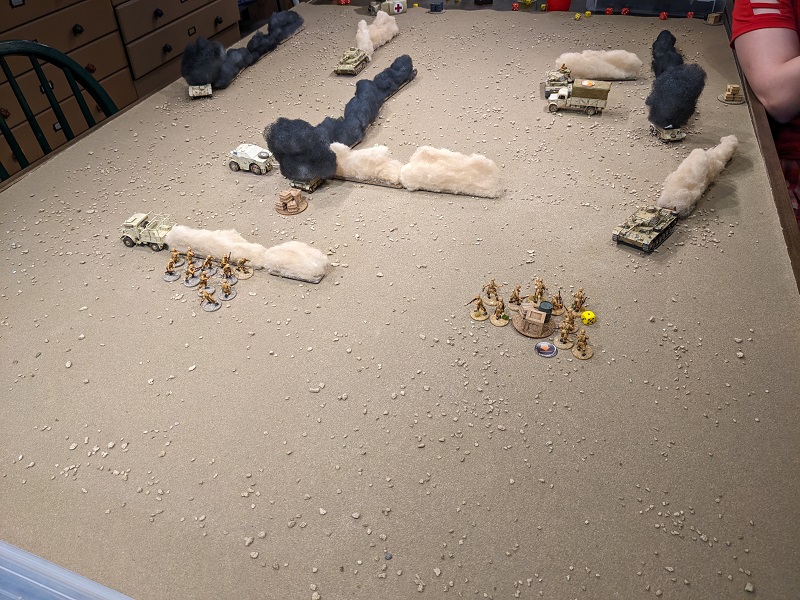

Turn 2, Phase 1 (South African): 5543 – The 25-lb gun deployed from the Allied JOP in the northeast corner of the board – it’s not like range was going to be an issue – and immediately took a shot at the Pz IV D. Unsurprisingly it scored a hit, but Lily’s armor save roll was miraculous. Still, it resulted in a roll on the “0-net hits” table, and the big tank added a point of Shock and was forced to reverse. The 4 was spent activating Borenhaas, who concentrated on keeping the trucks and supply clerks all moving, with the supply truck actually making it off the table to safety.
Sgt. Borenhaas felt the ground shake and the air squeeze from his lungs as the nearby artillery gun fired. Usually he was well behind them – being right in front was much less pleasant. Again he had the uncanny experience of seeing the air change as the shell passed through it at high speed. A tremendous explosion sprang up just in front of an oncoming Pz IV, an extremely near miss that caused the enemy tankers to reverse course. That was all well and fine, but he and his men needed to cross the artillerymen’s line of fire to get to safety. He hoped to hell those cannon cockers wouldn’t send one down range right over their heads. Or through their bodies.
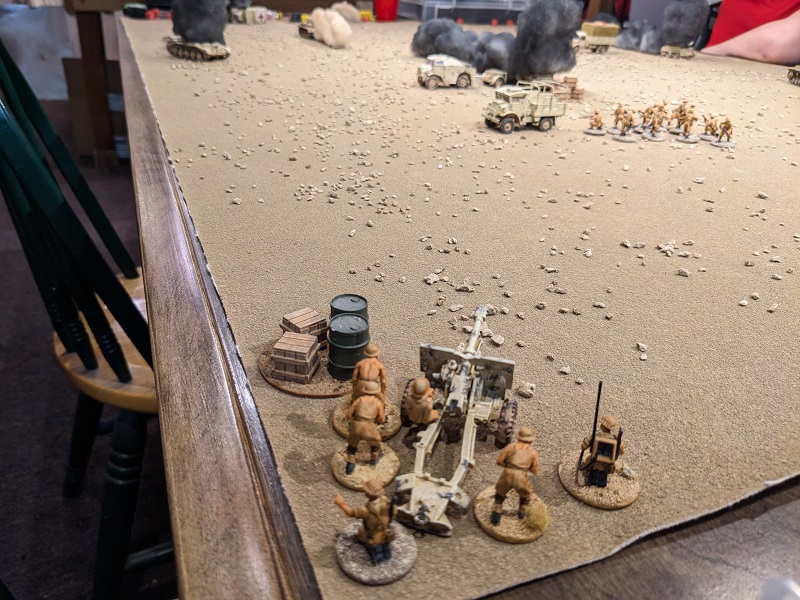
Turn 2, Phase 2 (German): 553322 – Wasted Red Die aside, this was another great roll for the Germans. Ehrenreich took his mandatory engagement action at 2nd Section, putting a kill on the Bren team and a kill and a Shock on the rifle team. Unfortunately, one of those kills turned out to be a wound on the section’s lance corporal – he was wounded and lost a CI. South African Force Morale took a tumble to 6. Next, the Pz II deployed and also unloaded on 2nd Section. It only had line-of-fire to the rifle team, but it inflicted another whopping 2 kills and 3 Shock. This put them one point shy of being pinned, but at least no further leader hits resulted. Via radio, Krauss ordered the Pz IV D to take a shot at the ammo carrier before it escaped. When that shot missed by a wide margin, he ordered his own gunner to engage it, though obscured by smoke this shot also missed.

Turn 2, Phase 3 (South African): 66431 – Another double phase! Time to tee up the artillery! The big gun switches targets to fire at Ehrenreich’s panzer (because Borenhaas is between the gun and the Pz IV), again scoring a hit, adding a point of Shock and causing it too to reverse. The wounded lance corporal of 2nd Section uses a CI to rally off a point of Shock, desperately trying to keep the men from being pinned. Finally, Sgt. Borenhaas spends a CI to see the ammo truck safely off the table and 1st Section continuing eastward on foot.
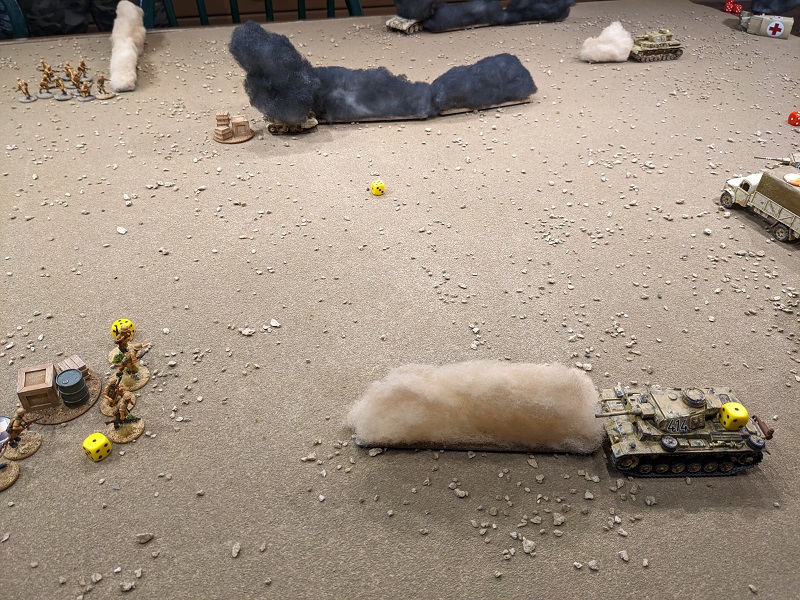
Turn 2, Phase 4 (South African): 6321 – Working like a well-oiled machine, the crew of the 25-lb gun rams another round into the breach and fires. Firing again at Ehrenreich, this time the shot is dead on target. It’s a tight fit squeezing through the hatch combing in such a hurry, and the portly Ehrenreich probably loses a few buttons doing it, but he and at least part of his crew successfully exit the vehicle as it begins to burn. For the first time in this campaign the South Africans have out-and-out destroyed a German tank, and German Force Morale drops two points to a 9. Meanwhile, 2nd Section’s wounded junior leader pulls off another single point of Shock (which is all he can manage now that he’s down to a single CI).
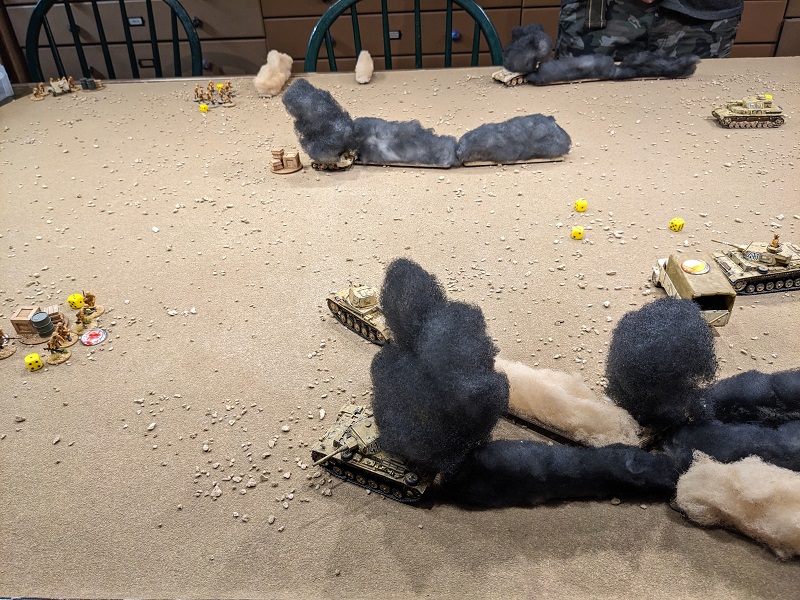
Turn 2, Phase 5 (German): 654422 – As command rolls go, this one is pretty awful. All that can be activated is Krauss, so he spends one CI ordering the Pz IV D to use its 75 mm cannon to blow up Borenhaas’ fleeing logistics men, firing his own co-ax at the same target to direct his subordinate’s fire. The idea here is that these men are green and in the open and have an attached senior leader (also green and in the open), increasing the chances of doing some kind of damage that might result in a Force Morale loss. The combined fire is suitably deadly – inflicting one kill and one Shock on each of the section’s teams – but no leaders are hit. Krauss’ final CI is spent ordering the Pz II C to move flat out headed for the northern board edge.
Aside: One of the special rules for the Germans in this Pint-Sized Campaign is called “Armored Advance,” and goes something like this: the Germans can end any scenario and progress to the next rung in the campaign ladder by advancing a tank off the northern board edge. This does not constitute a scenario victory, and the Germans must give up any surrendered objective vehicles that have not already been captured by infantry. They also lose the opportunity to re-crew any intact tanks whose crew have bailed due to excess Shock. The Germans don’t win the scenario, but they also don’t lose time. It is very much a double-edged sword. By advancing the Pz II C this way, Lily is hedging her bets.
Turn 2, Phase 6 (South African): 54422 – with a regular senior leader still in reserve, John deploys him now, along with 3rd Section (also upgraded to regular). One of the newly deployed lieutenant’s CIs is spent getting the men of 3rd Section sorted (deployed in tactical stance). This is a regular infantry unit pulling close security for the gun crew and another is spent ordering the 25-lb gun to fire. It takes a shot at Krauss’ command tank, but the obscuring smoke throws off the aim. Finally, Borenhaas rallies two Shock off his clerks and has them hoof it. They move 11″, cleanly crossing the artillery gun’s line of fire.

Aside: In game terms, the regular infantry squad in tactical stance is the exact same to-hit and cover-save as the regular gun crew with a gun shield. That means that these units will now “share hits,” as they are effectively indistinguishable from one another. This makes the gun crew more resilient to incoming fire.
Turn 2, Phase 7 (German): 554332 – The Pz II C advances at normal speed and fires its 20mm autocannon at the enemy artillery. This fire inflicts one kill on the gun crew and one Shock on 3rd Section’s Bren team. The Pz IV D slowly advances and fires its own main gun at the 25-lb gun, this time inflicting one kill on 3rd Section’s Bren team and one Shock on the gun crew. No leaders are hit. Then hilarity ensued.
Tired of sitting on the battlefield like a cooked goose and waiting around for infantry to come and take control of this damned truck, Krauss decided enough was enough. Cranking the turret around until its 50mm cannon was pointed straight at the truck’s cab, he yelled, “Los!” Without hesitation his gunner fired. Expecting some effect, Krauss was dumbfounded when the dust cleared and the intact truck still sat before him. He could see the shattered glass where the tank round had passed through both side windows without detonating. Yelling in frustration, he squeezed the trigger on his co-ax, peppering the enemy vehicle indiscriminately. The last of the magazine having run dry, he surveyed to truck over the machinegun’s now-smoking barrel. When the unbelievably fortunate driver’s head poked up over the edge of the door, Krauss didn’t know whether to scream or cry. The man would likely spend the rest of his life profoundly deaf, but the fact that he was alive at all was miraculous.
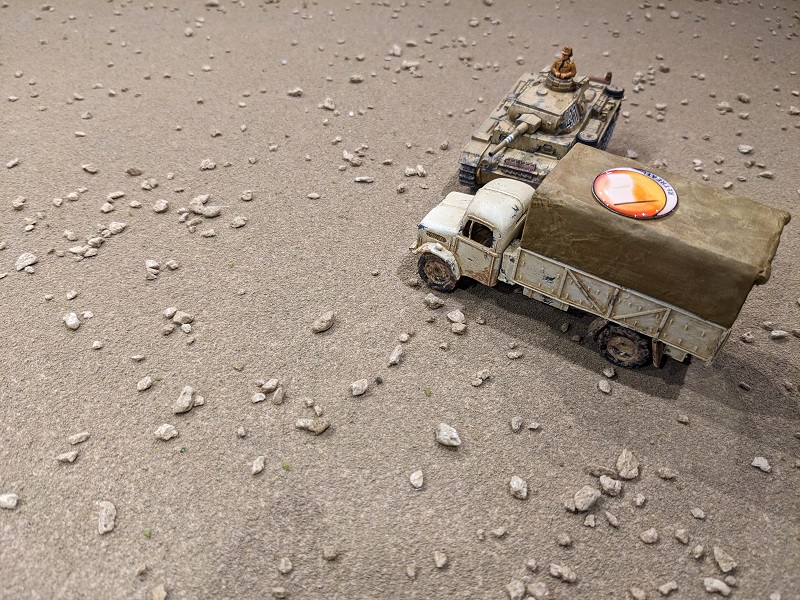
Turn 2, Phase 8 (South African): 65552 – This roll doesn’t let the South Africans do anything that they want to do, but it does give them a full Chain of Command Die. John passes the turn to the Germans and immediately uses this CoC Die to perform an interrupt. This turns out to be a shot by the 25-lb gun at the Pz IV D, which is a direct hit. The tank begins to smoke. and as the crew bails out flames can be seen licking out from the open hatches. German Force Morale drops two more points to 7 – now nearly on par with the South Africans’ 6.
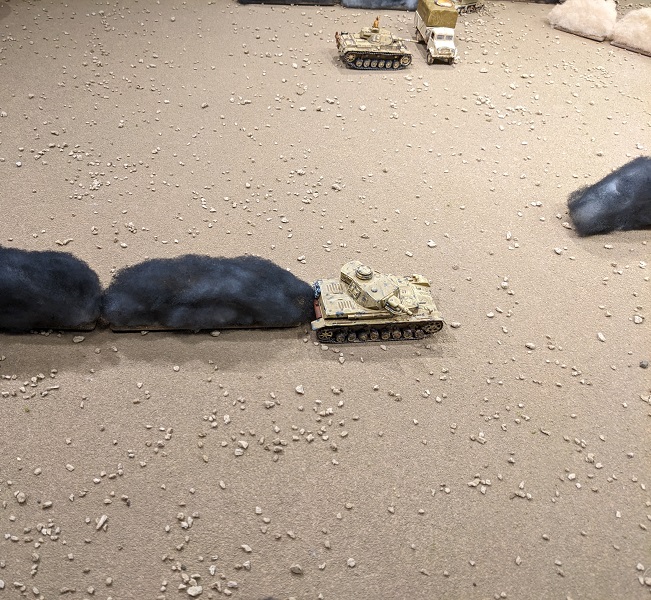
Turn 3, Phase 9 (German): 652211 – The Pz IV D was supposed to advance slowly and engage the enemy artillery again, but so much for that plan. Now the Pz II C continues its headlong race northward, ending up just a few inches shy of the table edge. With a complete CoC Die of their own, the Germans can end the game by using an interrupt and driving the little tank off the table edge using the “Armored Advance” special rule. Not wanting to risk further destruction, Lily does just that.
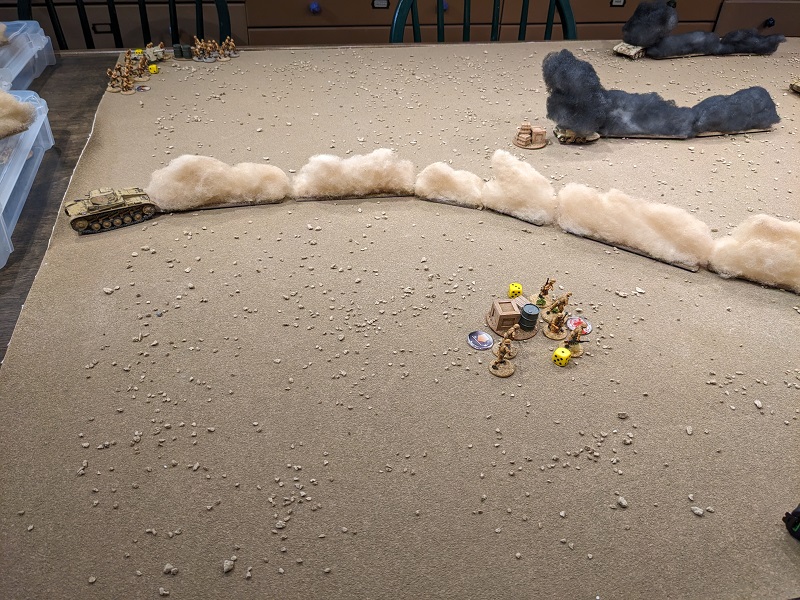
Static crackled in Leutnant Krauss’ headset, followed by an awful lot of vociferous yelling from his commanding officer. It seemed that another platoon in the company had pushed even farther north, gotten tangled up with something they couldn’t immediately handle, and were frantically calling in reinforcements. There was no time to waste mucking about with all these trucks, especially not with that 25-lb gun still in action. That would have to be mopped up by the infantry following in their wake – or at least the infantry that was supposed to be following in their wake. As little as Krauss liked it, he switched over to the platoon net and ordered all of his remining tanks to advance at full speed. He could already see the little Pz II that had been attached to his platoon racing forward as it undoubtedly got similar orders from its own chain of command. Casting a look backwards as his tank lurched forward, Krauss caught the unmistakable sight of the portly Berndt Ehrenreich and his crew piling into a conveniently and incongruously abandoned Kubelwagen and heading for the rear. But at least they were alive – for now.
Postgame Campaign Stuff
The Germans gained no Victory Points in this scenario. Even though the transport truck had surrendered, the use of the “Armored Advance” special rule meant that the Germans had to let it go (once Krauss proved incapable of actually destroying it). Worse, advancing in this way means that while the Germans progress to the next rung in the campaign ladder, they can’t actually count this as a win for the purposes of either the CO’s opinion or Krauss’ outlook. Instead it’s a draw, which is not nearly as beneficial. With a good roll the CO’s opinion remains unchanged (at a +4, still giving Krauss’ platoon an extra point of Support for the next game). Krauss’ outlook suffers slightly, however, dropping from “Popular” back down to “Sociable.” It’s still enough to give the young platoon commander a +1 to the next game’s Force Morale roll, but perhaps a little bit of the shine has worn off the man’s reputation within the unit.
Worse, for the purposes of comparing casualties when calculating the Men’s Opinion, each destroyed German tank counts as 5 men regardless of whether or not the crew escaped. That’s 10 casualties, less 1 for the Germans finishing with one point higher Force Morale. The South Africans suffered 8 casualties, but for this calculation you only count the number of men “killed” (or dispersed or missing or wounded badly enough that they are unable to return to service), which is half (round down) of your total casualties. That rounding down is actually all that saves the Germans from sustaining worse casualties than the South Africans. As such, the German Men’s Opinion holds steady at +5 by the thinnest of margins.
For the South Africans, this game was a huge boost. Since all three objective vehicles are considered to have escaped, that’s 2 points for the supply truck, 3 for the troop transport, and 4 for the ammunition carrier. Additionally, the destruction of two Germans tanks are worth a point each, for a total of 11 Victory Points. After all is said and done, the new Campaign Victory Point tally stands at:
South Africans: 20
Germans: 16
Like the Germans, the Men’s Opinion of South African side remains unchanged at -7. Just because they KO’d a couple of tanks doesn’t mean they’re in the clear yet.
Debrief
Wow, just like that the Germans went from being in the driver’s seat to falling behind. Things only keep getting harder for the Germans, so now they are faced with some extremely tough choices going forward.
In the early phases of the game, things were looking pretty bleak for the South Africans. Had there been even a couple more German phases before the turn end was rolled, I think the outcome would have been very different. Of the entire campaign, this mission is probably the most difficult for the South Africans. It forces them to play the entire first turn with just their “core” force, which only has the Boys rifle and paltry grenades as organic AT weapons. Right up until he rolled the Turn End, John was sweating, and even after that Lily was still doing a good job getting her tanks moving and firing.
But once the 25-lb gun made it onto the field, the game changed dramatically. Especially with a regular squad there to provide security for the gun crew (i.e. to share hits), at that point the Germans just needed to get off the table as quickly as they could. I think Lily played this pretty much perfectly, seamlessly transitioning from “methodical advance-and-fire” to “go-go-go” on a dime. That recognition of the changing tactical picture while keeping the overall strategic goals of the campaign in sight was cool to see.
Not being able to destroy the truck right in front of Krauss’ tank was in some ways a critical part of this battle. Had it been destroyed, the total Victory Point score would have been tied up at 17-17. Then again, nothing ever goes according to plan in combat, and sometimes unexpected and ridiculous things happen.
The sense that the Germans’ early victories had banked enough VP for them to rest on their laurels and coast to a campaign victory was illusory before, but now the grim reality is laid bare: the Germans are going to have to work at this if they want to win it. And not all of them are going to make it to the end of this thing.
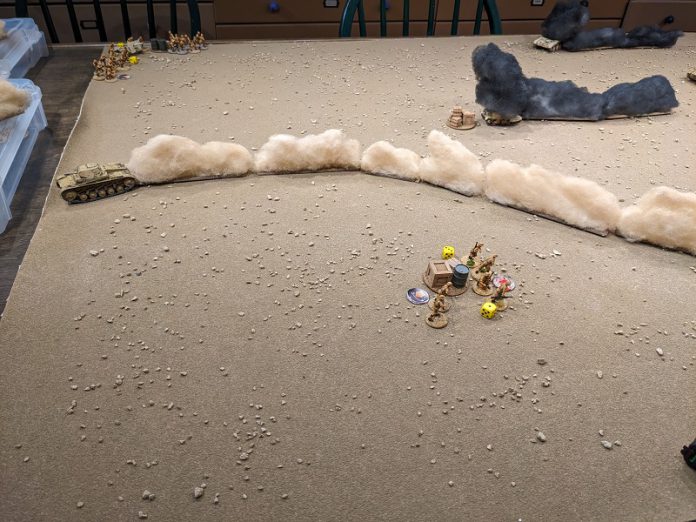


You must be logged in to post a comment.